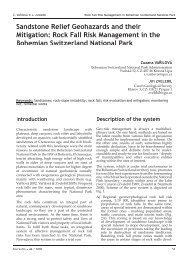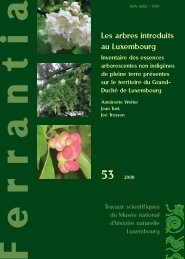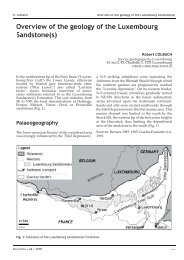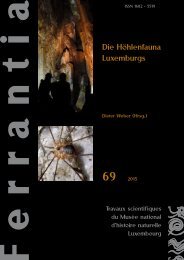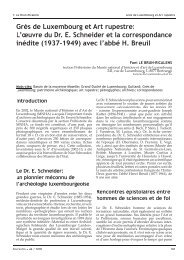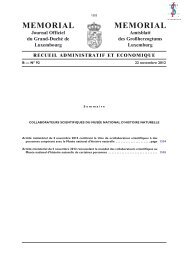1st International Recorder Conference - Extranet - Musée national d ...
1st International Recorder Conference - Extranet - Musée national d ...
1st International Recorder Conference - Extranet - Musée national d ...
Create successful ePaper yourself
Turn your PDF publications into a flip-book with our unique Google optimized e-Paper software.
First circular and registrationCollating and managingnatural sciencefield and collection recordsin EuropeLuxembourg, 2-3 December 20051 st <strong>Inter<strong>national</strong></strong> <strong>Recorder</strong> <strong>Conference</strong>.ConvenerLuxembourg National Museum of Natural HistoryPartnersBundesamt für Naturschutz, DeutschlandJoint Nature Conservation Council, Peterborough, U.K.National Biodiversity Network, U.K.Natural History Museum, U.K.Royal Botanical Gardens, Kew, U.K.Société des naturalistes luxembourgeois, LuxembourgWith the support ofLuxembourg National Research FundOf interest to• Field recorders and recording scheme organisers across Europe• Biological and geological museums looking for software to managespecimens, collections and field records• Managers of biological records centres and geodiversity record centres• Organisations charged with delivering biodiversity or earth sciencesdata and advice to planners, local and <strong>national</strong> governments• Those involved in developing or managing local and <strong>national</strong>biodiversity networks including BioCASE and GBIF nodes• Those involved in developing web-based biodiversity informationsystems• Developers of information standards and ontologies for biological andearth sciences
1 st <strong>Inter<strong>national</strong></strong> <strong>Recorder</strong> <strong>Conference</strong> , 2-3 december 2005ThemeSustainable development and the conservation and enhancement of biodiversity have beencentral to all European environmental and economic policy since the signing of the RioConvention in 1992. Meeting these objectives requires ready access to scientifically valid,reliable and comprehensive wildlife and earth sciences data at local, regional, <strong>national</strong> andEuropean levels.National projects such as the National Biodiversity Network in the UK and European-fundedprojects such as ENHSIN and BioCASE have helped develop techniques and standards forbiodiversity data sharing but there is still a great need for software and standards that cancapture, manage and integrate the original natural sciences collection and field data. Thetheme of this meeting is to introduce field biologists, earth scientists and natural sciencemuseum curators across Europe to software and standards that can meet this need and discussways in which it could be deployed throughout Europe.The meeting will include presentations on the development of <strong>Recorder</strong> 1 and its associatedapplications (including ‘thesaurus’ and collections management software) in the UK andLuxembourg. <strong>Recorder</strong> has been developed at public expense and is readily available to userson a not-for-profit basis. The emphasis of the meeting will be on the development and use ofdata standards and how the <strong>Recorder</strong> suite of applications could help build integrated systemsfor the collation, management and dissemination of information in the natural sciences acrossEurope.The conference will cover the development of recording and data management standards andthe way they have been used in <strong>Recorder</strong>. There will be discussion of how <strong>Recorder</strong> can beused at different levels, from the individual naturalist through local, regional and <strong>national</strong>collation centres. Examples of working systems will be demonstrated and currentdevelopment work will be described including the inter<strong>national</strong>isation of the software to workwith different languages and mapping bases and the development of a web version.There will be presentations on the scope and potential of the BioCASE/LuxembourgThesaurus software for managing and controlling taxonomy and other terminology withexamples of how it is being utilised in <strong>Recorder</strong> and other applications. There will also bepresentations on the project to create and deliver a <strong>national</strong> taxon list for the UK andassociated web services in the Natural History Museum, London.The problems of developing, disseminating and sustainably supporting an inter<strong>national</strong>version of <strong>Recorder</strong> and associated software will be discussed and proposals made for futureaction1 For a brief description of <strong>Recorder</strong> see www.nbn.org.uk select <strong>Recorder</strong> 2002 from the products & services menu2
1 st <strong>Inter<strong>national</strong></strong> <strong>Recorder</strong> <strong>Conference</strong> , 2-3 december 2005List of topics and speakersTalks 25 minutes + 5 minutes discussionDay/Time Session Theme Speaker DurationDay 1: Friday 2 ndDecember 20059.30 –10.30Registration & coffee 9.30 –10.3010.30 –10.45Introduction &welcome10.45 –11.1511.15 –12.0012.00 –12.3012.30 –14.0014.00 –14.3014.30 –15.0015.00 –15.3015.30 –16.0016.00 –16.30Recording &Collation1. Overview of the<strong>Recorder</strong> Project2. Demonstration of<strong>Recorder</strong>applications3. Overview of datastandards for fieldrecording andcollectionsmanagement in thenatural sciencesLUNCH4. Using <strong>Recorder</strong>for biological recordsin the local context:collating and creatingproducts5. <strong>Recorder</strong> in themuseum context6. Import and exportof dataTEA/COFFEETerminology7. Creating andmanaging term listsand dictionariesOverview ofconference and whatwe hope to achieveIntroduction to thehistory anddevelopment of<strong>Recorder</strong> (2002, 6etc.)Integrated naturalsciences collectionsand observationsdata managementIntroduction to thedata model andstandards; the basison which <strong>Recorder</strong> isbuiltposters anddemonstrations<strong>Recorder</strong> 2002 / 6 –what it can do andhow it is usedexample from anactive local recordcentre<strong>Recorder</strong> 6 and itscollectionmanagementextensions – theLuxembourg projectImporting data fromother software usersand exporting data toGIS, the NBN etc.Introduction to theThesaurus1. GovernmentMinister orequivalent2. <strong>Conference</strong>ChairmanC. CoppEnvironmentalInformationManagementJ. Van BredaDorset softwareLtd.C.CoppEIMCharles RoperSussexBiodiversityRecord CentreGuy CollingLuxembourgNational NaturalHistory MuseumHannah BettsJoint NatureConservationCommittee UKGuy CollingLMNH1. 5minutes2. 10minutes30 minutes45 minutes30 minutes30 minutes30 minutes30 minutes30 minutes3
1 st <strong>Inter<strong>national</strong></strong> <strong>Recorder</strong> <strong>Conference</strong> , 2-3 december 200516.30 –17.0017.00 –17.30Evening8. Taxonomicnames and nameserversDiscussion andQuestionsReceptionNHM Taxon ListProjectsC.Hussey /J.TweddleNatural HistoryMuseum LondonChairman &speakers30 minutes30 minutesDay 2:9.00 –9.159.15 –9.459.45 -10.1510.15 –10.4510.45 –11.1511.15 –11.4511.45 –12.1512.15 –12.4512.45 –14.15Saturday 3 rdDecember 2005IntroductionUsing the InternetExamples of projectsthat deliverinformation to avariety of users overthe web and in which<strong>Recorder</strong> anddictionaries play apart9. Web-basedRecording software10. UK <strong>national</strong>system11. a UK regionalsystemCOFFEE12. Luxembourgsystem13. Other Web portalservice14. Linking to GBIFand otherinter<strong>national</strong> systemsLUNCH<strong>Inter<strong>national</strong></strong><strong>Recorder</strong> andrelated softwareDevelopment of<strong>Recorder</strong> Web and itspotentialThe NBN Gateway –a <strong>national</strong> systemCEDAR – a regionalsystemLuxembourg Project– building a <strong>national</strong>bio and geo diversityweb portalthe BioCASE ProjectThe GlobalBiodiversityInformation Facilityposters anddemonstrations<strong>Conference</strong>Chairman –Adrian RissoneNHM LondonJ. Van BredaDorset SoftwareLtdS. WilkinsonJoint NatureConservationCommittee UKDamian McFerranCentre forEnvironmentalData andRecordingNorthern IrelandTania WalischLuxembourgNational NaturalHistory MuseumAnton GuentschBotanic Gardenand BotanicalMuseum BerlinDahlemLarry SpeersGBIFmax 15minutes30 minutes30 minutes30 minutes30 minutes30 minutes30 minutes4
1 st <strong>Inter<strong>national</strong></strong> <strong>Recorder</strong> <strong>Conference</strong> , 2-3 december 200514.15 –14.4514.45 –15.1515.15 –15.4515.45 –16.1515.<strong>Inter<strong>national</strong></strong>ising<strong>Recorder</strong>16. <strong>Recorder</strong> Projectin Germany17. Supporting<strong>Inter<strong>national</strong></strong><strong>Recorder</strong>The work done so farin making <strong>Recorder</strong>available outside theUK and how it can betailored to differentlanguages andgeographic areas.The German webflora(www.floraweb.de)and the role ofrecorder: first resultsof the recorder pilotproject supported bythe BfN in GermanyDiscussion of how wefund and support theexpansion of<strong>Recorder</strong> use inEurope18. Future action Set agenda for nextactions and targetsTEA/COFFEE anddepartJohn Van BredaDorset SoftwareLtdAndreas Bettinger&Rudolf MayZentrum fürBiodokumentationSaarland,Bundesamt fürNaturschutzdiscussiondiscussion30 minutes30 minutes30 minutes30 minutesAbout the <strong>Recorder</strong> applications<strong>Recorder</strong> 2002 is a windows-based biological records collecting, collating and reportingpackage developed by the UK Joint Nature Conservation Committee (JNCC). <strong>Recorder</strong> 2002is based on the UK NBN data model and incorporates NBN data validation and transferstandards. The <strong>Recorder</strong> Project has been funded from public money and the software isessentially free although there is normally a small handling charge from appointed suppliersand users may pay for support, training or customisation.<strong>Recorder</strong> 2002 works against a MicroSoft Access/MSDE back-end database which can beinstalled for single users or small networks. A new version called <strong>Recorder</strong> 6 has beendeveloped for record collating centres who need to manage very large data holdings.<strong>Recorder</strong> 6 runs on a large-scale client-server data base (Microsoft SQL Server) and fullysupports NBN data standards. Both <strong>Recorder</strong> 2002 and <strong>Recorder</strong> 6 have been built in amodular way, which can easily be modified or extended through ‘add-in’ programs. <strong>Recorder</strong>6 has recently been extended to be able manage both earth science observations and museumcollections data, which would allow an organisation or group of organisations to create a fullyintegrated biodiversity, earth science and collections record system.A further attractive development for <strong>Recorder</strong> 6 is the design of a piece of software called<strong>Recorder</strong> Web. <strong>Recorder</strong> Web will allow organisations to give remote data entry andreporting facilities to any user, over the Internet via a web browser. <strong>Recorder</strong>s will be able toadd, review and edit their records and only submit them to the central database when theyare happy with them. <strong>Recorder</strong> Web will use record card style templates and these can beindividualised as required. It will also be possible to exchange the text-based data entry with asimpler picture interface for public participation surveys (e.g. garden birds, commonbutterflies etc. using photographs). The advantage of <strong>Recorder</strong> Web will be that the users willnot need any software on their computers (other than a standard web browser) and the hostorganisation (e.g. a record centre) can manage the data and ensure it complies to the agreeddata standards for any project.5
1 st <strong>Inter<strong>national</strong></strong> <strong>Recorder</strong> <strong>Conference</strong> , 2-3 december 2005Organising Committee:Guy Colling Luxembourg National Museum of Natural HistoryCharles Copp Environmental Information ManagementJim Meisch Luxembourg National Museum of Natural HistoryTania Walisch Luxembourg National Museum of Natural HistoryScientific Committee:John van Breda Dorset softwaresCharles Copp Environmental Information managementGuy Colling Luxembourg National Museum of Natural HistoryCharles Hussey Natural History Museum, LondonTania Walisch Luxembourg National Museum of Natural History<strong>Conference</strong> venueThe conference location is the old Abbey of Neumünster called Centre culturel derencontre Abbaye de Neumünster (CCRN). It is located in the UNESCO Worldheritage area in the Alzette valley overlooked by the old town of Luxembourg. It includesthree buildings of which the oldest goes back to the XVIIth century, surrounding a vastsquare. The rich past of this historic building and the multicultural vocation of Luxembourgare major topics of the CCRN. Meetings, debates, creations, spectacles, conferences,seminars, exhibitions and receptions are organized to promote the dialogue of cultures and theculture of dialogue. Within European networks and in partnership with many culturalinstitutions from different backgrounds, the CCRN favors the exchange of experiences andcontributes to trans<strong>national</strong> cooperations between actors of different cultural origins.The CCRN is close to the <strong>national</strong> Museum of natural History at the heart ofLuxembourg-CityAccommodationEach participant has to book him-/herself an accommodation (except for the peoplepresenting an oral communication). A list of hotels in Luxembourg will be proposed by theorganizer. Early booking is recommended.CostsReduced fees will apply to students of all member states and to scientists from new memberstates of the European Union. The total conference fee will be according to the time ofpayment:Early booking Latebookinguntil October 24th 2005 from October 25th 2005Full price 65 € 75 €Reduced fee 30 € 35 €This fee includes admittance to conference sessions, conference documents including abstractvolume, lunch and coffee breaks.6
1 st <strong>Inter<strong>national</strong></strong> <strong>Recorder</strong> <strong>Conference</strong> , 2-3 december 2005RegistrationFor registration please use the registration form on the conference homepage and send itelectronically (recorder@symposium.lu). Or fill in the enclosed form and send it by mail orfax to the conference secretariat. Please note that the conference capacity is limited. Deadlinefor registration is 14th of November 2005.PaymentBefore you pay, send your registration form and wait for a reply of the conference secretariat.You will be informed if conference places are still available. Please pay the conference fee inEuro and free of charge by bank transfer to account n° IBAN LU54 1111 1329 0010 0000 ofthe 'TRESORERIE DE L'ETAT CPTE MUSEE NAT D'HIST. NATURELLE' at Bank 'P&TLuxembourg, L-1090 Luxembourg', BIC code 'CCPLLULL'. Please use the conferenceabbreviation (<strong>Recorder</strong> 2005) as the payment identification. Deadline for early payment is <strong>1st</strong>November, 2005.CurrencyThe Luxembourg monetary unit is the Euro (EUR, €).CancellationCancellations have to be sent in writing to the conference secretariat address. If yourcancellation is received before November your payment will be refunded (minus bank costsof the transfer). No refunds can be made for cancellations after this date.Final circularThe final circular with detailed travel and program information will be distributed in October2005. It will also be presented on the conference homepage.Practical informationFor practical information, e.g. registration, transport, accommodation etc., please contact the<strong>Conference</strong> Secretariat:Tania Walischc/o Musée <strong>national</strong> d'histoire naturelle25, rue MünsterL-2160 LuxembourgPhone: (+352) 46 22 33 - 263Fax: (+352) 46 38 48e-mail: recorder@symposium.lu<strong>Conference</strong> homepagehttp://www.symposium.lu/recorder7




